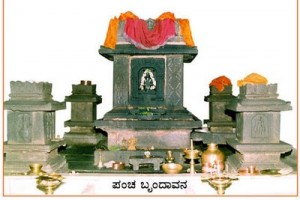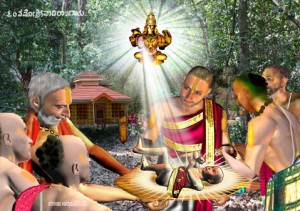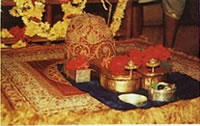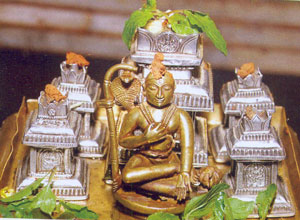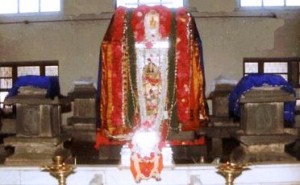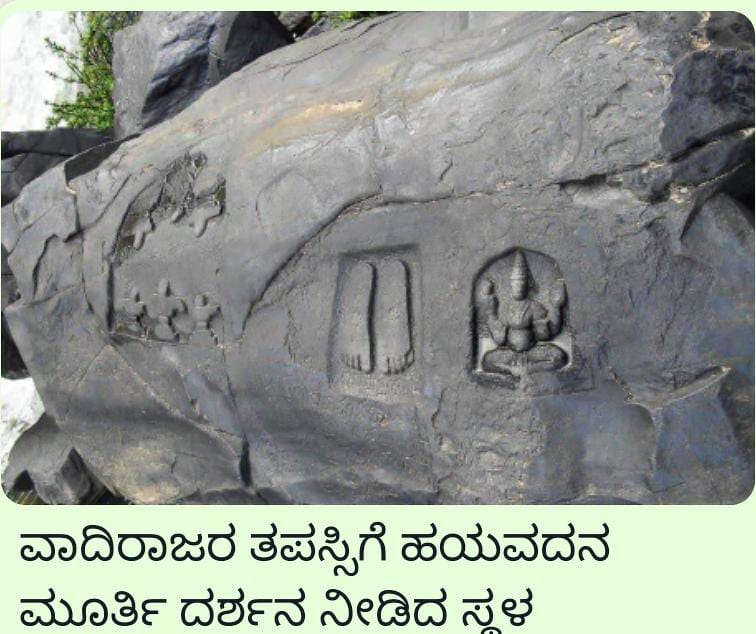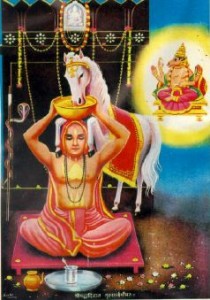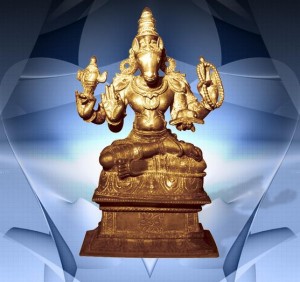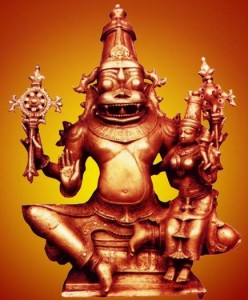Pancha Vrundavana – Vrundavana at Sonda
ತಪೋ ವಿದ್ಯಾ ವಿರಕ್ತ್ಯಾದಿ ಸದ್ಘುಣೌ ಘಾಕರಾನಹಮ್ |
ವಾದಿರಾಜ ಗುರೂನ್ ವಂದೇ ಹಯಗ್ರೀವ ದಯಾಶ್ರಯನ್ ||
ಕಾಮಧೇನು ಯಥಾಪೂರ್ವಮ್ ಸರ್ವಾಭೀಷ್ಟಫಲಪ್ರದಾ |
ತಥಾ ಖಲೌ ವಾದಿರಾಜ: ಶ್ರೀಪಾದೋ ಅಭೀಷ್ಟದ:ಸತಾಮ್||
ಮಾತಾ ರಾಜಾ ಮತ್ಪಿತಾ ವಾದಿರಾಜೋ ಭ್ರಾತಾ ರಾಜಾ ಮತ್ಸಖಾ ವಾದಿರಾಜ:|
ಸರ್ವಸ್ವಂ ಮೇ ವಾದಿರಾಜೋ ದಯಾಳು: ನಾನ್ಯದ್ದೈವಂ ನೈವ ಜಾನೇ ನ ಜಾನೇ |
tapO vidyaa viraktyaadi sadGuNou Gaakaraanaham |
vaadiraaja gurUn vaMdE hayagrIva dayaashrayaan ||
kaamadhEnu yathaapUrvam sarvaabhIShTaphalapradaa |
tathaa khalou vaadiraaja: shrIpaadO abhIShTada:sataam||
maataa raajaa matpitaa vaadiraajO bhraataa raajaa matsaKaa vaadiraaja:|
sarvasvaM mE vaadiraajO dayaaLu: naanyaddaivaM naiva jaanE na jaanE |
ವಾದಿರಾಜರು ಸಶರೀರರಾಗಿ ವೃಂದಾವನ ಪ್ರವೇಶ ಮಾಡಿದ್ದಾರೆ. ಸಶರೀರರಾಗಿ ವೃಂದಾವನ ಪ್ರವೇಶ ಮಾಡಿದ ಪ್ರಪ್ರಥಮರು. ಇವರ ನಂತರ ರಾಯರೂ ಸಶರೀರರಾಗಿ ವೃಂದಾವನ ಪ್ರವೇಶಿಸಿದ್ದಾರೆ
Jeevana Charitre(Life History) – click
Vadirajara Granthagalu – click
Vadirajarara Krishnastakam – click
Vadirajara “Devaranamagalu” – click
ಲಘು ವಾಯುಸ್ತುತಿ Vayustuti in Kannada by Vadirajaru
Narayanana nene manave – devaranama – click
THIRTHA PRABANDHA – click for KANNADA SANSKRIT TELUGU TAMIL
THIRTHA PRABANDHA – SHAIVA KSHETRAS – Click
THIRTHA PRABANDHA – NARASIMHA KSHETRAS .
THIRTHA PRABANDHA – HARI + HARA KSHETRAS
NARAYANA VARMA BY VADIRAJARU & VYASARAJARU – CLICK
Born with the Anugraha of Vaageesha Thirtha – Once Sri Vaagisha Tirtharu of Sri Vishnutheertha Mutt happened to visit the Village Hoovinakere (It was also called as Kumbhasi). There, Ramabhatta and Gowridevi Dampathigalu begged the sheeegalu to bless them with a child. Sri Vaageesha Tirtharu blessed him and imposed a condition that the child born to be handed over to the Mutt for upbringing. That too only if the child happens to born outside the house, then they shall hand over to the Mutt not otherwise. The couple agreed wholeheartedly thinking that the child will be born inside the house.
Nine months completed. On one Sadhana Dwadashi day, i.e, on Magha Shudda Dwadashi, Gowri was performing Tulasi Puja early in the morning. She saw some cows entering the paddy fields which they own, and the cows started eating and destroying the crops. Gowri took a stick and chased the cows, moved quite a distance from the house forgetting the agreement with the Sri Vageesha Tirtharu. Suddenly her pregnancy pain started and she could not return home and delivered the child in the field itself.
Immediately Sri Vaageesha Tirtharu was informed of the birth of the child and a golden plate was sent from the Mutt and the child was brought to the Mutt. The baby never touched the ground until it reached the Mutt. The baby was fed with the milk that had been offered to the deity as naivedya; and the parents named the boy as “Bhoovaraha”. The paddy fields which Gowri gave birth to the child is called as “Gowri Gadde”. Sri Vaageesha Tirtharu sent the boy back to her parents and with an instruction to bring back after a few years.
The child was growing like a Pournima Chandra. Bhoovaraha learnt all skills and studied well right from his early days itself. After some time the swamiji asked the parents to hand over the boy to the mutt. The parents with reluctance handed over the boy to the seer. Sri Vageesha Tirtharu told the parents that the services of the child is required for the prachara of Madhwa Tathwa.
Paaduke of Vadirajaru
ಪಂಚವೃಂದಾವನದಿ ಮೆರೆವ ವಾದಿರಾಜರು
pancha vrundavanadi mereva vaadiraajaru
It is the only one Vrundavana which has five Vrundavanas built. (One for Vadirajaru, and the other four Vrundavanas equipped with the special presence of Vishnu, Brahma, Vayu and Rudra.)
ಪಂಚವೃಂದಾವನಗಳಲ್ಲಿ ಯಾವ ದೇವರ ಸನ್ನಿಧಾನವಿದೆ. –
ಪಂಚವೃಂದಾವನದ ಸುತ್ತಲೂ ಬ್ರಹ್ಮದೇವರು, ಮುಖ್ಯಪ್ರಾಣದೇವರು, ಮಹಾವಿಷ್ಣು, ಮಹರುದ್ರದೇವರು, ಮಧ್ಯದಲ್ಲಿ ವಾದಿರಾಜರು ಇದ್ದಾರೆ.
ಮಧ್ಯ ವೃಂದಾವನದ ಮುಂಭಾಗದಲ್ಲಿ ಶ್ರೀ ಹಯಗ್ರೀವದೇವರು, ಸುತ್ತಲೂ ರಾಮ, ಕೃಷ್ಣ, ವೇದವ್ಯಾಸರ ಸನ್ನಿಧಿಯಿದೆ. ಬೃಂದಾವನದ ಮಧ್ಯದಲ್ಲಿ ವಾದಿರಾಜರು, ಪ್ರದಕ್ಷಿಣೆ ಆಕಾರದಲ್ಲಿ ಹನುಮ, ಭೀಮ, ಮಧ್ವರು ಇದ್ದಾರೆ. ಉಪವೃಂದಾವನದಲ್ಲಿ ಮತ್ಸ್ಯ, ಕೂರ್ಮ, ವರಾಹ, ನರಸಿಂಹ, ವಾಮನ, ಪರಶುರಾಮ-ಶ್ರೀರಾಮರು, ಕೃಷ್ಣ, ಬುದ್ಧ, ಕಲ್ಕಿ ಮೂರ್ತಿಗಳಿವೆ. ಈ ಎಲ್ಲ ದೇವತೆಗಳನ್ನೂ ಧ್ಯಾನಿಸುತ್ತಾ ವಾದಿರಾಜರು ಹಯಗ್ರೀವ ಭೂವರಾಹ ಸನ್ನಿಹ ಮಧ್ಯ ವೃಂದಾವನದಲ್ಲಿ ಸನ್ನಿಹಿತರಾಗಿರುತ್ತಾರೆ.
Lakshmi Shobana Lirics in : Kannada – click Sanskrit – click
ವಾದಿರಾಜರ ಜನ್ಮ ಸ್ಥಳ – ಹೂವಿನಕೆರೆ – ಕುಂಭಾಸಿಯಿಂದ 5 ಕಿಲೋಮೀಟರ್ ದೂರದಲ್ಲಿದೆ. ಕುಂಭಾಸಿಯಲ್ಲಿ ಗೌತಮ ಋಷಿಗಳು ಗಂಗಾ ಸನ್ನಿಧಾನವನ್ನು ತರಿಸಿದ್ದಾರೆಂದು ಪ್ರತೀತಿ.
ಕುಂಭಾಸಿ ಕ್ಷೇತ್ರ – ಕುಂಭ + ಅಸಿ = ಕುಂಭಾಸಿ . ಕುಂಭ = ಅಸುರ, ಅಸಿ – ಖಡ್ಗ. ಇದು ಹಿಂದೆ ಭೀಮಸೇನ ದೇವರು ಕುಂಭ ಎಂಬ ಅಸುರನನ್ನು ಖಡ್ಗದಿಂದ ಸಂಹರಿಸಿದ ಸ್ಥಳ .
ಜನ್ಮದಿನ – ಶಾರ್ವರಿ ಸಂವತ್ಸರ ಮಾಘ ಶುದ್ಧ ದ್ವಾದಶಿ
ಜನ್ಮ ನಕ್ಷತ್ರ – ಸ್ವಾತಿ
ಜನ್ಮಸ್ಥಳ – ಕುಂಭಾಸಿ ಬಳಿಯ ಹೂವಿನಕೆರೆ (ಕುಂಭಾಸಿಯಿಂದ ೫ ಕಿಲೋಮೀಟರ್)
ಜನ್ಮನಾಮ – ಭೂವರಾಹ
ತಂದೆ ತಾಯಿ – ರಾಮಾಚಾರ್ಯರು (ದೇವಭಟ್ಟ) ಮತ್ತು ಗೌರೀದೇವಿ
ಮಹಾಭಾರತ ಲಕ್ಷಾಲಂಕಾರ – ವಾದಿರಾಜರ ತಾಯಿ ಮಗ ಹುಟ್ಟುವ ಮೊದಲು – ಮಗು ಹುಟ್ಟಿದರೆ ದೇವರಿಗೆ ಲಕ್ಷಾಭರಣವನ್ನು ಅರ್ಪಿಸುತ್ತೇನೆ ಎಂದು ಹರಕೆ ಹೊತ್ತಿದ್ದಳು. ಆದರೆ ಆಭರಣದಿಂದ ಮಾಡಲಾಗಲಿಲ್ಲ. ಶ್ರೀ ವೇದವ್ಯಾಸರ ಪ್ರೇರಣೆಯಂತೆ ಮಹಾಭಾರತ ಲಕ್ಷಾಲಂಕಾರ ಗ್ರಂಥವನ್ನು ಸಮರ್ಪಿಸಿ ತಾಯಿಯ ಹರಕೆ ಪೂರೈಸಿದರು
Born on – Shaarvari Samvatsara Magha Shudda Dwadashi
29.1.1481 – kRista shaka 1403
Janma nakshatra – Svaati
Birth Place – Hoovina Kere 25 miles from Udupi
Parents – Ramabhatta and Gowridevi
Janma Naama – Bhoovaraha (Varahaacharya)
Upanayana – In his fifth year
Initial Gurugalu – Srinivasacharyaru, Vidyanidhi Tirtharuy
Ashrama Sweekara – in 1488 AD (he was 8 years)
In Sode Mutt parampare, he is the 20th yati.
Ashrama Gurugalu – Vaagisha Tirtharu
Ashrama Shishyaru – Vedavedya Tirtharu
Vrundavana Pravesha – 1600 AD.
Aradhana Day – Palghuna Bahula Trithಎ
(He is the first to enter Vrundavana alive )
ವಾದಿರಾಜರ ಪರ್ಯಾಯ ಅವಧಿ ಯಾವುದು –
1532-1533; 1548-1549; 1564-1565; 1580-1581; 1596-1597
Sanyasa Tenure – 112 Years
His ankitha – Hayavadana ಹಯವದನ
He has composed more than 1000 Suladi, Devaranamas, ugabhogas, etc.
Sanyasashrama to Bhoovaraha
Bhoovaraha or Varahacharya learnt Veda, Vedanga, Madhwa Shastra etc from Sri Vageesha Theertharu. After seeing the child’s vast knowledge, vairagya, Jnana Bhakthi, he decided to give him Sanyashrama at the age of 8 years and was given the name “Vaadiraaja Theertha” Sri Vaadirajaru studied under Sri Vaagisha Theertharu until his Vrundavana Pravesha. After some time, Sri Vageesha Theertharu entered Brundavana, then for further studies, Sri Vadirajaru went to Sri Vyasarajaru in Hampi, where he met Purandara Dasaru, Kanakadasaru, Sri Vishnu Theertharu (later Vijayeendra Theertharu) and King Krishnadevaraya.
Honour by Sri Krishnadevaraya – King Krishnadevaraya was impressed by Vaadiraaja’s personality and gave him the title of “prasangaabharaNa Theertha”“ (Jewel of a Speaker). Vaadiraaja returned back to Udupi after a few years. As a parting gift, Sri Vyaasaraajaru gave him the “Vyaasa mushti” that had been gifted to him during a trip to Udupi.
Tirupathi Darshana
During his visit to Tirupathi hills, the entire hill and each and every stone looked to him, as full of “Saaligrama” and he ascended the entire hill with his knees and hands only without the help of his legs. The Saligraama garland worn by Srinivasa was a humble offering made by Sri Vadirajararu.
Hayagreeva Idol
Once a goldsmith was melting a metal for making an idol of Ganapathi. The goldsmith tried and tried but could not do so even after several attempts. Each it was becoming an idol of Hayagreeva icon. That night the goldsmith was instructed in his dream to hand over the idol to Vaadirajaru. Similarly Vaadirajaru also received a dream wherein he was instructed to receive the Hayagreeva idol from the Goldsmith. Next day, the goldsmith went to Sri Vadirajaru and offered the Hayagreeva idol . Subsequently, the entire group of the goldsmith community from that region was provided with Chakrakana and were brought under Sonda Mutt.
Vaadiraaja Tirtharu’s special Hayagreeva Naivedya
Vaadirajaru used to offer Hayagreeva Naivedya to Hayagreeva Devaru. Hayagreeva consists of Jaggery, ghee, channa dall, almonds, grapes etc. Every day Hayavadana would emanate from the icon in the form of a white horse, eat Naivedya putting his forelegs on Vadiraja Tirtha’s shoulders. Vaadirajaru used to sing Dashavatara Stuti and that the Hayavadana roopi horse used to dance to his appreciation every day.
Hayavadana ate the Vishapooritha Hayagreeva to save Vaadirajaru – Once, some miscreants tried to test Vaadirajaru and put poison in the Hayagreeva meant for the naivedya. That day Hayavadana ate the complete Hayagreeva without leaving anything as prasadam. When Vaadiraajaru asked Hayavadana, why nothing is left as prasada, then god told it was because of poison, he had eaten entire Hayagreeva. The Lord also told him that the icon would develop a bluish-green tinge all over its body as proof . Vaadiraaja would have to offer ‘Vaadiraaja Gulla’ as naivedya for some period, when the tinge would gradually diminish, leaving just a streak of green at the neck to remind posterity of this incident. It is only because of this that the Vadiraja Gulla is being used by Sonda Mutt. Even though Gulla Vegetable is not to be used for cooking, only because of Sri Vaadirajaru using it in Sonda, Udupi people use Gulla.
Reforms by Vaadiraajaru –
- Paryaya – Initially all the disciples of Srimadacharya used to perform the pooja of Sri Krishna. Subsequently it was changed to two months rotation for each mutt, wherein also the Mutt Seers had problems in managing the Mutt Administration. In 1532, Sri Vadirajaru, created the Paryaya System for the Sri Krishna Pooja and each Asta Mutt Seer would get 2 years term for their Administration and Pooja of Sri Krishna Mutt. Vaadiraajaru has completed 5 terms of Paryaya at Udupi.
- Anugraha to Arasappa Nayak – Arasappa Naika was the Chieftain or King of Soda, an independent Province after the fall of Vijayanagar Empire. Entire Nayak’s army was attacked by rebels and enemies, which made Arasappa Nayaka to flee out of Soda and on the way, he met Sri Vadirajaru and surrendered to his feet. Vadirajaru gave him Mantrakshate and blessed him and instructed to go back and fight against the enemies. Nayaka went back and fought with them and had a grand success and Sode was liberated. Immediately he asked Vadirajaru to come to Soda and for him he constructed a very nice premises, temples, etc. Vaadirajaru used the bell given by Arasappa Nayaka with Basava at the head of the bell instead of Hanuman . That is why we can see the Basava Bell being used by Sonda Vadiraja Mutt (Whereas everywhere we find Hanumanthana bell).
- Construction of Rama Trivikrama Temple in Sonda – Arasappa Nayaka constructed a very good temple for Rama Trivikrama Devaru to be brought from Badari. For bringing the Rama Trivikrama Devaru alongwith a chariot, Vadirajaru sent in Bhootarajaru. While Bhootarajaru was bringing the Chariot he was attacked by some demons, he then immediately took one Wheel of the Chariot and defeated the demons. He then reached Sonda in time before the Maha Pooja. Even today, one can see, the Rama Trivikrima Devaru placed in a big chariot with only 3 wheels and one wheel missing in Sonda.
- Subsequently Vadirajaru shifted from Udupi to Sonda or Sode or Swadi on the banks of Shalmali River (Shalmali River flows in the Tapovana where he used to do paata to his disciples) as it is popularly called and gave ashrama to Vedavyasa Thirtha as his successor.
There are a lot of similarities between Sonda and Udupi.
- Dhavalagange Sarovara in Sonda & Madhwa Sarovara in Udupi
- Dhavala Gangadhareshwara & Chandramouleshwara in Sonda & Udupi respectively.
- Mukhya praana prathiste done in both places by Vaadiraajaru.
- Anugraha to Bhootarajaru –
Once there lived a Brahmana named Narayanacharya. He was a shishya of Vadirajaru and was serving well. Once he showed disrespect to Vadirajaru and expressed his doubt on Vadiraja’s activities. Vadirajaru cursed him to become a Brahmarakshasa and after some time, Vadirajaru blessed him and he is being worshipped at Sonda. Sri Vadirajaru has blessed him that those who come to Sonda, must first have the darshana of Bhootarajaru, then only one must have the darshana of Vadirajaru. Every day, Bhootaraja Bali is being done at Sonda.
Vaadraaja Tirtha’s Granthagalu –
- Rukminisha Vijaya
- Theertha Prabhanda
- Swapna Vrundavanakyanam
- Sarasa Bharathi Vilasa
- Kavi Kadamba Kanta bhushana
- Mahabhaaratha Lakshalankara Teeka
- Talavakaropanishad Bhashya Teeka
- Taittareeyopanishad Bhashya Teeka
- Kathakopanishad Bhashya Teeka
- Atharvanopanishad Bhashya Teeka
- Mandookopanishad Bhashya Teeka
- Tantra Saara Teeka
- Mahabhaaratha Prasthana
- Shatprashnopanishad Bhashya Teeka Tippani
- Mahabharatha Tatparya Nirnaya Bhavaprakashika
- Tatvaprakashika Guruvartha Deepika
- Ishavasyopanishad Bhashya Teeka Prakashana
- Geethabhashya Tippani
- Nyaya sudha Guruvartha Deepika
- Bhagavatha Anukramanika
Stotragalu –
- Ramesha Stuthi
- Dashavataara Stotra
- Dashavataara Stuti
- Hayavadana Astaka
- Narahari Astaka
- Roupya Peetha Krishna Stuthi
- Hayavadana Astaka
- Hayagreeva Panchaka
- Hayagreeva Dhyana Prakarana
- Hayagreeva Stuthi
- Hayagreeva Sampada Stotra
- Sri Krishna Stavana
- Dhee Shuddhi Stotra
- Varaha Hayavadana Stotra
- Aapada Stotram
- Ukti Pratyukthi stotram
- Aksha Panchakam
- Varaha Panchakam
- Sri Raama Kavacham
- Sri Raama Dashakam
- Sri Raama Panchakam
- Avataara Traya Stotram
- Swapna Padyam
- Vedavyasa Varnanam
- Vedavyasa Stotram
- Shlokatrayam
- Chaturvimshati Murthibedha Stotram
- Venkatesha Mangalastaka
- Runa Mochana Stotra
- Prarthana Dashakam
- Vishnu Stuthi
- Trivikrama Stotra
- Haryastaka
- Hayasya Dashaka
- Navagraha Stuthi
- Haribhakthyastaka
- Guru Stuthi
- Hitopadesham
- Sripadarajastakam
- Durga Stavana
- Madhwastakam
- Vibheeshana Hanumad samvaada roopa vaayustuthi
- Astamahishi yukta Krishna stotram
- Madhwamuni Prathapastaka
Kannada Granthagalu –
- Vaikunta Varnane
- Lakshmi Shobhane
- Keechaka Vadha
- Namaskara Stotra
- Naivedya Prakarana
- Swapana Pada
- Naarada Koravanji
- Bhagavatha Saara Keerthane
- Swapna Gadya
- Bhramara Geethe
- Gunda Kriye
Tirtha Prabhanda –
Sri Vaadiraajaru toured the entire “Bharatha Varsha” and visited almost all Tirtha kshetras in the country. He has written a book titled “Tirtha Prabhanda”, which is a master guide for the tourists with Anusandhana and Dhyana Shloka and Varnana of the Kshetra. It contains four adhyaayas viz., Prabandhaas – Paschima Prabandha, Uttara Prabandha, Poorva Prabandha, and Dakshina Prabandha.
Rukminisha Vijaya
श्रीवेदांत महाचलं हि परित: संयोज्य सूत्राहिपं
सद्वातागमपोषितात्महृदयं तत्पूर्वपक्षासुरै: ।
सिद्धांतोक्तिसुरेश्वरश्च मथितो य: कृष्णदुग्धांबुधि:
स्वीयानाममृतं प्रयच्चति स मां पायाद्गुणोध्यन्मणि: ॥ १ ॥ (mangalacharana shloka)
Once he was observing Chaturmaasya in Pune. There, he learnt that a Vidwat Sabha was organized to select the greatest Mahaakavya, and they were about to announce “Shishupala Vadha” by Magha a great poet as the Mahaakavya. Sri Vaadirajaru sent words to the organizers that he too has written a Shastra Kaavya Grantha, which is kept in Udupi, and asked them to include that also for evaluation for “Mahaakaavya”. The Organisers agreed and gave him 3 weeks time to bring it from Udupi.
To everybody’s surprise, he wrote the entire “Rukminisha Vijaya” Kaavya within a span of 19 days that too during his spare time and presented for evaluation. When this work was presented at the conference the scholars were swept away by its poetic brilliance and had no hesitation in declaring it as the greatest Mahaakavya in Sanskrit literature. In accordance with their decision, the manuscript was taken in a procession around the city on a well-decorated elephant, with a lot of fanfare and glory. Actually “Shishupala Vadha” as the name itself suggests, by naming itself is inauspicious named and does not pose the importance of Sri Krishna whereas it highlights importance for a villain.
But in Rukminisha Vijaya – Vaadirajaru has given a clear picture of Sri Krishna’s baalya, his childish behaviour, his plays with Gopika Streegalu. One must read the Kaavya or atleast hear the Kaavya – Rukminisha Vijaya to understand how fine it is. Normally a Kaavya gives us only story, sceneries, poems, etc., but Rukminisha Vijaya is not full of Story, sceneries, poems, explanations, but also gives as Tathva.
Rukminisha Vijaya Kaavya was completed in just 19 days with good poetic excellence, with tathwa. At that time Vaadirajaru was not so famous as “Maagha” – Magha was quoted as having all the 3 qualities of Kalidasa (Upamaa), Bhaaravi (Arthagowravam), and Dandi (Pada lalithya). Vaadirajaru’s work of Rukminisha Vijaya has defeated even MAGHA.
Dashavataara Stuti –
Once he had visited Pandarapura and stayed in a temple there and served Panduranga Vittala. An angry man came and abused Vaadirajaru “that your horse is eating the entire crop every day and ruining his farms and that he is not able to catch it”. Then Vadirajaru told him that we are not having any horse with us. The complainant searched for the horse in the entire mutt but could not trace it. Vaadirajaru realized what has happened and asked the complainant to take him to his field. When they arrived at the field and examined the crop, the owner was astonished to see golden corn at all the places where the horse had eaten his crop. Vaadiraajaru, explained to him that that the horse was Lord Hayavadana himself, and that he was very lucky to have seen him. The crop owner surrendered at the feet of Vaadiraajaru , and offered his land to the Matha. On the way back, Vaadiraaja composed the Dashaavataara Stuthi. This is set to Ashvadhaati and sung sounds like a horse dancing.
Ramesha Stuthi – This is the Stotra which one has to do paarayana early in the morning.
Vaikunta Varnane – This is a Kannada Grantha written by Vaadirajaru about the Vaikunta. He has explained about the vaibhoga of Vaikunta.
Lakshmi Shobhana – Once Arasappa Nayaka approached Sri Vaadiraajaru, and told that the groom to whom his daughter had to be married has died and asked his blessings on the groom and his daughter. Then Sri Vaadiraajaru composed Sri Lakshmi Shobane on the spot and the groom got back to life. This is a Kannada composition of Vaadirajaru and it is very popular because it is believed that singing this on the occasion of a wedding blesses the bride and groom with a long and happy married life.
Lakshmi Shobhane describes the appearance of Lakshmi born out of the Samudra Mathana and her wedding with Srimannaarayana. Here Sri Lakshmi Devi before putting the garland on Srimannaraayana lists the demerits of each gods other than Naarayana. This is another Harisarvottama Prathipaadaka Grantha/Stotra. It has 112 lines.
ಲಕ್ಷ್ಮೀಶೋಭಾನೆ – ಒಮ್ಮೆ ಅರಸಪ್ಪನಾಯಕನೆಂಬ ಜಹಗೀರ್ದಾರನ ಮನೆಯಲ್ಲಿ ಹಸೆಮಣೆ ಏರಬೇಕಿದ್ದ ವರ ಮರಣಗೊಂಡಾಗ, ಅವರ ಪ್ರಾರ್ಥನೆಯನ್ನು ಮನ್ನಿಸಿ, ಆ ವರನ ಮರಣವನ್ನು ಪರಿಹಾರ ಮಾಡಿ, ರಚಿಸಿದ ಪದಗಳೇ ಲಕ್ಷ್ಮೀಶೋಭಾನ. ಈ ಕೃತಿಯಲ್ಲಿ ಸಮುದ್ರಮಥನ ಕಾಲದಲ್ಲಿ ಪ್ರಕಟಗೊಂಡ ಲಕ್ಷ್ಮೀ ರೂಪವನ್ನು ವರ್ಣಿಸುವುದರ ಜೊತೆಗೆ ಹರಿಸರ್ವೋತ್ತಮತ್ವ ಪ್ರತಿಪಾದನೆ ಮಾಡಿ, ಬೇರೆಲ್ಲ ದೇವತೆಗಳಾರೂ ಶ್ರೀಹರಿಗೆ ಸಮರಲ್ಲ ಎಂದು ನಿರೂಪಿಸುತ್ತಾರೆ. ವಾದಿರಾಜರ ಲಕ್ಷ್ಮೀಶೋಭಾನಪದದಲ್ಲಿ ಒಟ್ಟು ೧೧೨ ನುಡಿಗಳಿವೆ. ಪ್ರತಿ ಮನೆಯಲ್ಲೂ ಮಂಗಳವಾರ, ಶುಕ್ರವಾರ ಈ ಕೃತಿಯನ್ನು ಹಾಡುವ ಸಂಪ್ರದಾಯವಿದೆ. ಮದುವೆ ಮನೆಯಲ್ಲಿ ವಧುವಿನ ಗೌರಿ ಪೂಜೆ ಸಂದರ್ಭದಲ್ಲಿ ಇದನ್ನು ಹಾಡಿ ಸುಮಂಗಲಿತ್ವವನ್ನು ಪ್ರಾರ್ಥಿಸುತ್ತಾರೆ.
Nyaya sudha Guruvartha Deepika – It is a commentary on Nyayasudha & Tathvaprakashika
Sarasa Bharati Vilasa– This is about the svarupa’s of Lakshi, Brahma (& vayu) and Saraswati (& Bharati).
Yukti-Mallika (work on logical analysis of different philosophical systems) – This is his Magnum Opus with 5 Chapters called Sourabhas. They are “Guna Sourabha”, “Shuddhi Sourabha”, “Bheda Sourabha”, “Sadhana Sourabha” and “Phala Sourabha”. There is also a commentary on this by Late Sri Satya Pramoda Thirtha of the Uttaradi Mutt.
Mahabharata-Prasthana (an independent view of Mahabharata by Veda Vyasa)- This work is called Mahabharata Lakshalankara an explanation of hundred thousand difficult words of the great epic Mahabharata.
Bhagavatha Anukramanika – It is a short and brief work on “Srimadbhagavatham”. It is called as “Bhagavatha Anukramanika”, containing the various aspects and stories narrated in Bhagavatha, wherein each word may give 3-4 sequential stories of Bhagavatha.
PaashaNdamatha KaMDana – This is the grantha written condemning Naastika jaina durmataas.ಶ್ರೀ ಅಚ್ಯುತದೇವರಾಯರು ವಾದಿರಾಜರ ಅಣತಿಯಂತೆ ಉಡುಪಿಯ ಅನಂತೇಶ್ವರ, ಚಂದ್ರಮೌಳೇಶ್ವರ, ಶ್ರೀ ಕೃಷ್ಣ ದೇವಾಲಯ, ಮಧ್ವ ಸರೋವರದ ಕಲ್ಲು ಮೆಟ್ಟಲುಗಳನ್ನು ಜೀರ್ಣೋದ್ಧಾರ ಮಾಡಿಸಿದನು.
ವಾದಿರಾಜರು ವಿಜಯನಗರದ ಅರಸ ಶ್ರೀ ಕೃಷ್ಣದೇವರಾಯನ ಕಾಲದಲ್ಲಿ ವಾಲಿಗುಹೆಯ ಸಂಪತ್ತನ್ನು ಬಹಿರಂಗಗೊಳಿಸಿ, ಅಲ್ಲಿದ್ದ ವಾಲಿಪೂಜಿತ ವಿಠಲ ಮೂರ್ಥಿ, ಸುಗ್ರೀವ ಪೂಜಿತ ಶ್ರೀರಾಮಮೂರ್ತಿಯನ್ನು ಪಡೆದು, ಪೂಜಿಸಿದರು.
ದೈವಜ್ಞ ಬ್ರಾಹ್ಮಣರು ತಯಾರಿಸಿದ ಗಣೇಶ ವಿಗ್ರಹ, ಗಣೇಶನ ವಿಗ್ರಹವಾಗದೆ, ಹಯಗ್ರೀವ ದೇವರ ವಿಗ್ರಹವಾಗುತಿತ್ತು. ನಂತರ ಅದನ್ನು ವಾದಿರಾಜರಿಗೆ ಸಮರ್ಪಿಸಿದರು. ಆ ಮೂರ್ತಿ ವಾದಿರಾಜರಿಗೆ ಬಿಳಿ ಅಶ್ವರೂಪದಿಂದ ಕಾಣಿಸಿತು. ಆಗ ಅವರಿಂದ ಸ್ತುತಿಸಲ್ಪಟ್ಟ ಸ್ತೋತ್ರವೇ ದಶಾವತಾರ ಸ್ತುತಿ ಅಶ್ವಧಾಟಿಯಲ್ಲಿ.
ಧವಳಗಂಗಾ ಸುತ್ತಲೂ ಯಾವ ದೇವರನ್ನು ವಾದಿರಾಜರು ಪ್ರತಿಷ್ಟಾಪಿಸಿದ್ದಾರೆ ?
ಪಶ್ಚಿಮದಲ್ಲಿ ಮುಖ್ಯಪ್ರಾಣ ದೇವರು, ಉತ್ತರದಲ್ಲಿ ವೇಣುಗೋಪಾಲದೇವರು, ಸಂತಾನ ಗೋಪಾಲಕೃಷ್ಣ, ವಾಯುವ್ಯದಲ್ಲಿ ಅನಂತೇಶ್ವರ, ಆಗ್ನೆಯದಲ್ಲಿ ಪಾತಾಳಗಂಗಾ, ಪೂರ್ವದಲ್ಲಿ ಪಂಚಬೃಂದಾವನಗಳ ಮಂದಿರ, ದಕ್ಷಿಣದಲ್ಲಿ ಚಂದ್ರಮೌಳೇಶ್ವರ
ನಾಗಪ್ರತಿಷ್ಟೆ – ದೆಹಲಿ ರಾಜ ನೀಡಿದ್ದ ಹೇರಳ ನಾಣ್ಯಗಳನ್ನು ಬಂಗಾರದ ಕವಚ ಮಾಡಿ ಶ್ರೀಕೃಷ್ಣ ಮಹಡಿಗೆ ಹೊದ್ದಿಸಬೇಕೆಂಬ ವಾದಿರಾಜರ ಅಪೇಕ್ಷೆ ಬೇಡವೆಂದು ಸ್ವಪ್ನವಾಗಲು ಉಡುಪಿಯ ಶ್ರೀಕೃಷ್ಣಮಠದ ಉತ್ತರ ಭಾಗದಲ್ಲಿ ಭೂಗತ ಮಾಡಿ ಮೇಲೆ ನಾಗಪ್ರತಿಷ್ಟೆ ಮಾಡಿದರು.
ವಾದಿರಾಜರು ಭೀಮಸೇನ ಕರಾರ್ಚಿತ ನರಸಿಂಹ ವಿಗ್ರಹವನ್ನು ಉತ್ತರ ಬದರಿಯಲ್ಲಿ ಭೀಮಕುಂಡದಲ್ಲಿ ಪಡೆದರು
ವಾದಿರಾಜರು ಶ್ರೀನಿವಾಸನ ದರ್ಶನಕ್ಕೇ ಹೋದಾಗ ಬೆಟ್ಟದ ಸೋಪಾನಗಳು ಸಾಲಿಗ್ರಾಮ ರೂಪದಲ್ಲಿ ಕಂಡವು. ಅದಕ್ಕೆ ಬೆಟ್ಟದ ಸೋಪಾನಗಳನ್ನು ಮೊಣಕಾಲಿನಿಂದ ಏರಿದರು.
ಶ್ರೀ ವಾದಿರಾಜರ ಕೆಲವು ಉಗಾಭೋಗಗಳು :
ಅಡಿಗಾಧಾರವಿಲ್ಲ ಹಿಡಿವುದಕೆ ಕೊಂಬಿಲ್ಲ
ಕಡೆಹಾಯಿಸುವರಿಲ್ಲ ಕಷ್ಟಪಟ್ಟೇನಲ್ಲ
ಕಣ್ಣೀರು ಬಿಡಲಿಲ್ಲ ಕಾಯಸುಖಪಡಲಿಲ್ಲ
ಉಣಹೋಗಿ ಬಾಯ ಮರೆತಂತಾಯಿತಲ್ಲ
ಬಡತನವು ಬಿಡಲಿಲ್ಲ ಭಂಗಪಟ್ಟೇನಲ್ಲ
ಗರುಡ ಸರ್ಪದ ಸ್ನೇಹದಂತಾಯಿತಲ್ಲ
ಎನ್ನ ಮನದುಬ್ಬಸವ ಸ್ವಾಮಿ ಶ್ರೀಹರಿಯೇ ಬಲ್ಲ
ಇನ್ನಾರಿಗುಸುರಲೋ ಶ್ರೀ ಹಯವದನರಾಯ |
ಅರ್ಚಿಸುವೆನೆಂಬಾಸೆ ಘನವಯ್ಯ ಹರಿ ನಿನ್ನ
ಮೆಚ್ಚಿಸಿ ಬದುಕುವೆನೆಂಬ ಮನದಾಸೆ ಘನವಯ್ಯ
ಕೆಚ್ಚಿ ಹಾರಿ ಹೋರಿ ಬೆಚ್ಚಿಸಿ ಉದರದ
ಕುಚ್ಚು ಪೆಚ್ಚಿಪ ಬಲುಹುಳಿಯಂತೆ
ಹುಚ್ಚು ಮಾಡಿಕೊಳುತಿದೆ
ಅಚ್ಚ ಸರ್ವೇಶ ನಿಚ್ಚದಲಚ್ಚ್ಯುತ
ನಿನ್ನ ಮೆಚ್ಚಿದೆನೋ ಸಚ್ಚಿದಾನಂದ
ಶ್ರೀ ಹಯವದನ |
ಅನ್ನದಾಸೆಗೆ ಪರರ ಮನೆಯ ಬಾಗಿಲ ಕಾಯ್ದು
ಅನೇಕ ಬಾಧೆಗಳಿಂದ ನೊಂದೆನಯ್ಯ
ಅನ್ಯತ್ರ ಪೋಡಮಟ್ಟು ಪೋಗಲೀಸರು ಅವರು
ಮನ್ನಿಸಿ ಕೃಪೆಯಿಂದ ಕೂಡಿಕೊಂಡಿರಲು
ಅನಾಥಬಂಧು ಶ್ರೀ ಹಯವದನನೇ
ನಿನ್ನ ಮನೆಯ ಕುನ್ನಿಯಂಜಲಿಕ್ಕಿ
ನೀನು ಪೊರೆಯೋ ತಂದೆ |
ಒಂದು ಬೊಮ್ಮ ಚಿತ್ತು ಒಂದು ಜೀವ ಚಿತ್ತು ಇಂ-
ತೆಂದು ಶೃತಿಸ್ಕಂಧ ಚೇತವೆಲ್ಲ ಗ್ರಂಥಹಾಸ್ಯ-
ದಿಂದ ಒರೆಯೆ ಹರಿ ಜಡನೋ ಹರ ಜಡನೋ
ಮಂದಹಾಸದಿಂದ ಜಡರು ಮನುಮುನಿಗಳೆಲ್ಲ
ಇಂಥಾ ಶಿವನ ವಹಿಸಿಕೊಂಡು ವಾದಿಸುವವರು
ಹಿಂದು ಮುಂದರಿಯರೆಂದು ಹಯವದನ ನಗನೇ |
ಕಾಲು ತೊಳೆದವನೊಬ್ಬ ತೊಳೆಸಿಕೊಂಡವನೊಬ್ಬ
ಮೌಳಿಯ ಮೇಲಾಜಲವ ಧರಿಸಿದವನೊಬ್ಬ
ಪಾಲಿಸುವ ಪ್ರಭುವೊಬ್ಬ ಕೊಲುವ ತಳವಾರನೊಬ್ಬ
ಮೂರ್ಲೋಕವರಿಯೆ ಪುಟ್ಟಿಸಿದ ಪಿತನೊಬ್ಬ
ಆಲೋಚನೆಯಲ್ಲಿ ಬಲ್ಲವರಿಗೆ ಸಂಶಯ ಸಲ್ಲ
ಮಾಲೆಯನು ಮಹಲಕುಮಿ ಹಯವದನಿಗಿತ್ತಳಾಗಿ |
ಕಾಶಿಯೊಳು ರಾಮಮಂತ್ರೋಪದೇಶ ಮಾಳ್ಪ
ಈಶ ಜಾಣರ ಮತದಿ ಜಗಕೆ ಗುರುವೆಂತೆಂಬ
ಆ ಶಿವನ ಮಂತ್ರದೇವತೆ ತಾರಕಬೊಮ್ಮನೆನಿಪ
ವಾಸುದೇವನೆ ಜಗಕೆ ಪರದೈವ ಕಾಣಿರೋ
ಈ ಸುತತ್ತ್ವವ ಪೇಳ್ವ ಹರಗೆ ನಮ್ಮ ಹಯವದನ
ಏಸು ಮನ್ನಣೆಯ ಮಾಡಿದರುಚಿತ ಕಾಣಿರೋ |
ನಲ್ಲನಿಲ್ಲದ ಸತಿ ಚಲುವಿದ್ದು ಫಲವೇನು
ಸಲ್ಲದ ಹೆಣ್ಣಿಗೆ ಸವಿಯಿದ್ದು ಫಲವೇನು
ಬಲ್ಲವರಿಲ್ಲದ ಸಭೆಯಿದ್ದು ಫಲವೇನು | ನಮ್ಮ-
ನೊಲ್ಲದ ಹಯವದನ ಎಲ್ಲಿದ್ದರೇನು ?
ನಿನ್ನ ಧ್ಯಾನದ ಶಕ್ತಿಯ ಕೊಡು
ಅನ್ಯರಲಿ ವಿರಕ್ತಿಯ ಕೊಡು
ನಿನ್ನ ಪಾದಾರವಿಂದದ ಭಕ್ಟಿಯ ಕೊಡು
ನಿನ್ನಲಿ ಭವಸಂಪತ್ತಿಯ ಕೊಡು
ಉನ್ಮತ್ತ ಜನರ ಅತ್ತತ್ತ ನೂಕುವ
ಚಿತ್ತತತ್ತ್ವದ ಕೃತ್ಯವ ಕೊಡು
ಕತ್ತಲೆ ಎನ್ನೊಳು ಭವ ಮುತ್ತಿದೆ ಹಯವದನ
ನಿನ್ನ ನಂಬಿದೆ ಕೃಷ್ಣ, ಅನ್ಯರೊಬ್ಬರ ಕಾಣೆ
ಪನ್ನಗ ರಕ್ಷಕನೆ ಬಾರೋ, ಇರುಳು ಹಗಲು ನಿನ್ನ
ಚರಣಕ್ಕೆ ಮೊರೆಹೊಕ್ಕೆ ಸರಿಯಾರೋ
ಈರೇಳು ಜಗದೊಳು ಹಯವದನ |
ಮದಮತ್ಸರದಿ ಬಂದು, ಕೆಲವು ಕಾಳವ ಕಳೆದೆ
ಕುದಿವ ಕಾಮಕ್ರೋಧಗಳಲ್ಲಿ ಸಂಕಟಗೊಂಬೆ
ಅಂಧಕನಾಗಿ, ಪರರ ಬೇಡಿ, ಬೇಸರನಾದೆ
ಸಾಧನಸಂಪದಕ್ಕೆ ಹರಿಪಾದವನ್ನು ನೆರೆನಂಬದವರೊಳಗೆ
ಬಹು ವ್ಯಾಧಿಗಳಲ್ಲಿ ಸಂಕಟಗೊಂಬೆ
ಪದುಮನಾಭ ಹಯವದನನ್ನ
ಪಾದವನ್ನು ನಂಬೋ ಮನವೇ |
ಮೂಲರೂಪದಿ ಸುರರು ದ್ವಾರಕಾಯಾತ್ರೆಯಲಿ
ಪಾಲಸಾಗರ ಯಾತ್ರೆ ಗರ್ಭಯಾತ್ರೆ ಕೇಳಯ್ಯ
ಶೂಲಧರ ಖಳಗಂಜಿ ಭುವನವೆಲ್ಲವ ಸುತ್ತಿ
ಶ್ರೀಲೋಲನಿಹ ವೈಕುಂಠಯಾತ್ರೆಯಿಂದ ಬದುಕನೆ
ಭೂಲೋಕದಲಿ ಪುಟ್ಟಿ ಹಯವದನ ಕೃಷ್ಣ ಮಾಡಿದ
ಕೈಲಾಸಯಾತ್ರೆ ಕೈವಲ್ಯಪತಿಗೆ ಲೀಲೆ |
“ಯಂ ಬ್ರಹ್ಮ ವೇದಾಹಂ ಬ್ರಹ್ಮದೇವ”
ಶೃತಿಶಬ್ಧಬ್ರಹ್ಮವೆಂಬ ವೇದ ಬೋಧಿಸಿತಾಗಿ
ಇಂಥ ಮನುಜರಿಗೆಲ್ಲ ಸದ್ಭಾವವ ಪೇಳ್ವ
ಹೊಂದಿ ಬದುಕು ಹಯವದನನ ಚರಣವ
ಹೊಂದಿ ಬದುಕೋ ಜೀವ ಹರಿಯೇ ನಾನೆನ್ನಬ್ಯಾಡ |
ಲಕ್ಷ್ಮೀಶೋಭಾನೆ – ಒಮ್ಮೆ ಜಹಗೀರ್ದಾರನ ಮನೆಯಲ್ಲಿ ವರನ ಮರಣವನ್ನು ಪರಿಹಾರ ಮಾಡಿ, ರಚಿಸಿದ ಪದಗಳೇ ಲಕ್ಷ್ಮೀಶೋಭಾನ.
ವಾದಿರಾಜರ ಲಕ್ಷ್ಮೀಶೋಭಾನಪದದಲ್ಲಿ ಒಟ್ಟು ೧೧೨ ನುಡಿಗಳಿವೆ. ಪ್ರತಿ ಮನೆಯಲ್ಲೂ ಮಂಗಳವಾರ, ಶುಕ್ರವಾರ ಈ ಕೃತಿಯನ್ನು ಹಾಡುವ ಸಂಪ್ರದಾಯವಿದೆ. ಮದುವೆ ಮನೆಯಲ್ಲಿ ವಧುವಿನ ಗೌರಿ ಪೂಜೆ ಸಂದರ್ಭದಲ್ಲಿ ಇದನ್ನು ಹಾಡಿ ಸುಮಂಗಲಿತ್ವವನ್ನು ಪ್ರಾರ್ಥಿಸುತ್ತಾರೆ.
ಶೀ ಕಮಲಾಪತಿದಾಸರು ಶ್ರೀವಾದಿರಾಜರನ್ನು ಕೊಂಡಾಡುವಾಗ ಹೀಗೆ ನುಡಿದಿದ್ದಾರೆ.
ಒಂದು ಕ್ಷಣದಲ್ಲಿ ವಾದಿರಾಜರ
ದ್ವಂದ್ವ ಪದವನು ಭಜಿಸುವವರಿಗೆ
ಬೆಂದು ಹೋಗ್ವುದು ಪೂರ್ವಜನ್ಮದ ದುರಿತಕಾನನವು
